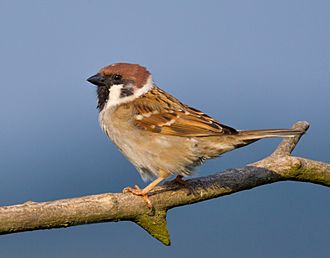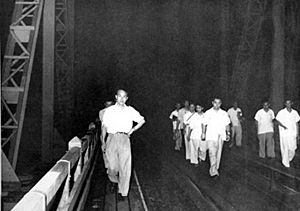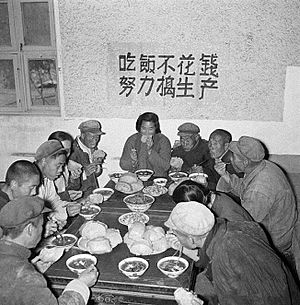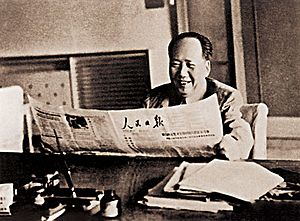Great Chinese Famine facts for kids
Quick facts for kids Great Chinese Famine三年大饥荒 |
|
|---|---|
| Country | People's Republic of China |
| Location | Half of China. The worst-hit areas were Anhui, Chongqing, Sichuan, Guizhou, and Hunan. |
| Period | 1959–1961 |
| Total deaths | 15–55 million |
| Observations | Considered China's most devastating catastrophe. |
| Theory | Result of the Great Leap Forward, people's commune, Four Pests campaign and other factors. |
| Consequences | Termination of the Great Leap Forward campaign |
The Great Chinese Famine (Chinese: 三年大饥荒; literally "three years of great famine") was a terrible famine that happened in China between 1959 and 1961. Some experts also include the years 1958 or 1962. It is known as the deadliest famine and one of the biggest man-made disasters in all of human history. It's estimated that between 15 and 55 million people died from starvation. The provinces hit hardest were Anhui, Chongqing, Sichuan, Guizhou, and Hunan.
The main reasons for the famine were the policies of the Great Leap Forward (1958 to 1962). These policies were started by Chairman of the Chinese Communist Party Mao Zedong. They included poor ways of sharing food, bad farming methods, and the Four Pests campaign which killed sparrows and upset nature. Also, officials often lied about how much food was being grown. Millions of farmers were told to stop farming and make iron and steel instead. In 1962, Liu Shaoqi, who was then President of China, said that 30% of the famine was due to natural disasters and 70% was due to human mistakes.
Contents
What Caused the Great Famine?
The Great Chinese Famine happened because of a mix of extreme farming rules, pressure from society, poor economic management, and natural problems like dry spells and floods.
The Great Leap Forward Policies
During the Great Leap Forward, farming was organized into large groups called people's communes. Farmers were not allowed to grow food on their own small plots of land anymore. The government took control of farming more and more. Local leaders were given goals for how much food their communes had to produce. This food was then taken by the government and given out as it saw fit.
A journalist named Yang Jisheng explained in 2008 that food could not be sent to places where it was needed most. He said:
In Xinyang, people starved right next to full food warehouses. As they died, they cried out, "Communist Party, Chairman Mao, save us." If the food stores in Henan and Hebei had been opened, no one would have died. While people were dying all around them, officials only cared about meeting their food delivery goals.
New Farming Methods That Failed
Along with grouping farms together, the government ordered new farming methods. These were based on the ideas of a Russian farmer named Trofim Lysenko, whose ideas were later proven wrong.
One idea was called close planting. This meant planting seeds very close together, sometimes three or even six times closer than normal. The idea was that plants of the same type would not compete with each other. But in nature, they do compete, and planting them too close actually made them grow poorly and produce less food.
Another policy was deep plowing. Farmers were told to dig much deeper into the soil than usual (about 33 to 66 centimeters). The theory was that the best soil was deep down, and deep plowing would help roots grow extra strong. While deep plowing can sometimes help, in China, this policy generally made harvests worse.
The Four Pests Campaign

In the Four Pests campaign, people were told to kill mosquitoes, rats, flies, and sparrows. Killing so many sparrows caused a big problem. Sparrows eat insects that harm crops. With fewer sparrows, these crop-eating insects grew in number, and they ate much more of the crops.
The "Too Much Food" Mistake
Starting in 1957, Chinese officials began to report that they were producing huge amounts of grain. This happened because their bosses put a lot of pressure on them. However, the actual amount of grain grown in China was going down from 1957 to 1961.
This led to an "illusion of superabundance" (浮夸风), meaning people thought there was much more food than there really was. The Party believed they had a lot of extra grain. For example, Beijing thought that in 1960, state food stores would have 50 billion jin of grain, but they only had 12.7 billion jin. This mistake had serious effects and many historians believe it was a major reason for the widespread starvation.
Historian Yang Dali explained three main problems caused by this mistake:
- First, leaders moved land away from growing grain to grow other crops like cotton and sugar. They also moved many farm workers to factories. This made the government demand even more grain from the countryside.
- Second, Chinese leaders, especially Zhou Enlai, decided to sell more grain to other countries. They wanted to earn money to buy machines for factories.
- Finally, because everyone thought there was plenty of food, it seemed like a good idea to have public dining halls in the communes. All these changes quickly used up the country's food supplies.
Natural Disasters

In 1958, a big flood happened in the Yellow River region, affecting parts of Henan Province and Shandong Province. It was said to be the worst flood of the Yellow River since 1933. The flood affected over 741,000 people and covered more than half a million acres of farmland. The government said they had "won against the flood" after sending over 2 million people to help.
However, the government was encouraged to report only successes and hide problems. Because 2 million farm workers were sent away from their fields to help with the flood, crops were not cared for and much of the harvest was left to rot. Also, historian Frank Dikötter has suggested that many floods during the famine were not just from bad weather. They were also caused by huge, badly planned water projects that were part of the Great Leap Forward. During this time, people were building many dams and thousands of kilometers of new canals to move water. While some projects, like the Red Flag Canal, helped with irrigation, many people died from starvation, sickness, and drowning because of these massive projects.
What Happened After the Famine?
Early Reactions and Hiding the Truth
Local leaders often tried to hide the truth about food shortages and blame others to protect themselves. Mao Zedong was not fully aware of how much people in the countryside were starving. Birth rates dropped and deaths increased in 1958 and 1959. In 1960, Mao stopped eating meat for seven months, and Zhou Enlai cut down on his own food, to show support.
When Mao visited Henan province in 1958, local officials claimed they had increased crop yields by a huge amount. They called these "sputnik launches." But these numbers were fake. The fields Mao saw were also fake; officials had moved grain from many fields into one special field to make it look like a huge harvest.
These fake demonstrations trapped the local officials. They pushed farmers to reach impossible goals, using methods like "deep plowing and close planting." This made things much worse, and crops completely failed, leaving empty fields. No one dared to tell Mao his ideas were wrong. Farmers went to extreme lengths to keep up the lie. Some even grew seedlings in their beds and coats, then "planted" them in fields. The bedding made the plants look tall and healthy.
Just like in the terrible famine in Ukraine (the Holodomor) created by the Soviet Union, doctors were not allowed to write "starvation" as a cause of death on death certificates.
The Cultural Revolution Begins
In early 1962, a meeting called the "Seven Thousand Cadres Conference" took place in Beijing. More than 7,000 officials from the Chinese Communist Party attended. During this meeting, Liu Shaoqi officially announced his findings on what caused the great famine. The Great Leap Forward was declared "over" by the Party, and Mao Zedong's policies were criticized.
The failure of the Great Leap Forward and the famine made Mao Zedong step back from making many decisions. He gave more responsibilities to Liu Shaoqi and Deng Xiaoping. Liu and Deng then started a series of economic changes. These included policies like sanzi yibao (三自一包), which allowed some free market activities and gave families more responsibility for farming.
However, Mao Zedong, Liu Shaoqi, and Deng Xiaoping started to disagree more about how the country should be run. In 1963, Mao began the Socialist Education Movement. Then, in 1966, he launched the Cultural Revolution. During this time, Liu Shaoqi was accused of being a traitor because he had said that only 30% of the famine was due to natural problems. Liu was denied medicine and died in 1969. Deng Xiaoping was also accused of being a "capitalist roader" and was removed from his positions twice during the Cultural Revolution.
Images for kids
-
Liu Shaoqi visiting North Korea (1963).
See also
 In Spanish: Gran hambruna china para niños
In Spanish: Gran hambruna china para niños






